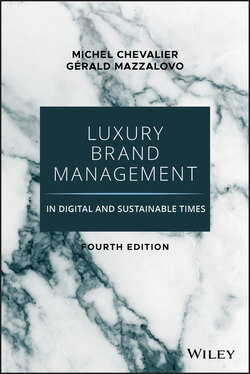Читать книгу Luxury Brand Management in Digital and Sustainable Times - Michel Chevalier - Страница 32
Five Sources of Legitimacy
ОглавлениеIf luxury is defined by an opposition to a standard, if the credibility and the competitiveness of a luxury brand are built on the choice of this norm and on the type of selected deviations, what may be the main sources that will establish the legitimacy of luxury brands?
Gilmore and Pine, in their book Authenticity, suggest five main sources of brand authenticity.21 They can be extended to the world of luxury.
What the authors call authenticity does not correspond exactly to the notion of true or real luxury that we introduced with the veracity square. Rather, they deal with brand credibility, that is, their ability to be recognized as a genuine sign of luxury. Whether we consider authentic, intermediate, discreet, or ostentatious luxury, all brands need sources of luxury legitimacy, each of them according to their respective needs. The intermediary luxury, for example, does not escape this requirement; but because of economic constraints, it will focus its efforts in communication and marketing where they are the most efficient, rather than on the products themselves.
Here are the sources of authenticity identified by Gilmore and Pine:
The natural. It is the prerogative of the brands that rely on natural materials to legitimize an ecological approach, or cultivate a Rousseauist simple wildlife. Luxury has always used this approach: linen, cashmere, vicuña, precious metals and woods, and plant extracts are often utilized by luxury brands in products and communication, even more so when the simplicity of the materials is synonymous with scarcity, thus reinforcing the true luxury symbolic value.
The original. The two authors especially have in mind the creative originality of objects or visuals. This source of differential legitimacy can be extended to all the brand manifestations. To be original means to be different from everything that existed previously. In communication, intermediate luxury cultivates originality, and even provocation. But it is also a source of major legitimacy for the big couture houses created by Dior, Chanel, Ferragamo, Valentino, and Saint-Laurent; combining their values of tradition with the audacity of talented couturiers, these houses manage to cultivate their strong identity.
The exceptional. This is another way to express a way to go beyond the ordinary. The authors apply it primarily to service activities, to describe an action especially sensitive to the needs of the client. In luxury, we will find hotels that base their reputation on this dimension, with a hint of extravagance—as with the famous Icelandic Ice Hotel, entirely carved in ice, or even tropical palaces of the luxury chain Aman Resorts, where staff feed fish reefs by hand. But we can add all the arts and crafts, and brands that rely on outstanding craftsmanship, such as the Hermès (Puiforcat, John Lobb, Saint-Louis) group.
The referential. The authors mean evocations of other contexts, historical in general, that serve as a benchmark for their clients; for example, the golden age of Roman Dolce Vita. The differential in this case is temporal: the concept of luxury is emerging out of a contrast between the present and the mythical period with which the brand wants to associate, in order to make us dream. This period will be suggested by an iconic object or a historical figure. The glamour of Ferragamo is built around international divas of the 1960s or 1970s (Audrey Hepburn, Sofia Loren, Anna Magnani), while Tod's seeks representatives among a certain Anglo-Saxon elegance: Steve McQueen, Sigourney Weaver. Other brands will put forward their association with an aristocrat, an artist, or a legendary athlete of the time. This so-called sponsorship from beyond the grave is a source of legitimacy more easily used by traditional historical brands. New entrants must use more recent or less-explicit references, often with lesser success.
The authority. Authority is understood as an ability to influence others based on a humanist cause. This resource is used by brands calling upon the values of solidarity, ecology, fair trade, and so on. So far, luxury has used these themes only anecdotally. Obviously, brands are careful to communicate all their social initiatives, but only a few luxury brands base their identity on these themes. There is, indeed, little correlation between luxury and ecology. The first cultivates rarity, exclusivity, and distinction, while the second reasons in terms of environment and mass phenomena. The value of selectivity places luxury at odds with any mass logic: if luxury has the means to pay its handicraft suppliers decently, it remains suspicious of environmental recklessness by its taste for rare materials.
